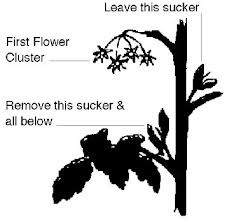
For new and old tomato growers alike, picking the abundant fruits in the backyard is a pleasure, until thwarted by the tangle of vegetable branches that seem to never stop growing. This New World native has multiple cooking uses, so it’s no wonder the vine happens to be America’s favorite garden vegetable. Letting the plant take over your garden bed can feel inevitable, but your tomatoes do not have to shade out your flowering annuals. Keep a cohesive and gorgeously maintained garden with these pruning know-hows:
Why it is Important to Prune
Pruning can start as early as the day you plant your tomatoes. Managing your plant’s growth both vertically and laterally can seriously impact its future health and fruit abundance. Tomatoes are a hardy crop with excitingly rapid growth. For the first month of the plant’s life it sends all of its energy to creating new leaves, causing it to double in size almost every 12 to 15 days. Because of this rapid growth it is wise to stake or cage your plants very early on in the year. It is possible that plants will grow too large to cage, or their weight can make staking difficult and dangerous for the stem. Choose to stake early to prevent these latter problems. For those of you who have not had the chance to stake your plants, do not worry, some clever pruning can eliminate a few of these problems.
The tomato will continue to produce energy through photosynthesis during the sunniest months, and once these production levels exceed what is needed for leaf growth, this excess energy will be sent off to stems for flower and fruit production. If the main stem, or even fruit bearing stems, are unsupported at the time fruit begins to grow, they can fall to the ground. Not only will the fruit fall, but if a gardener is not watchful, his or her plant can grow to exceed a four foot by four foot area. It is at this moment that the gardener realizes the nearby flowers are in danger of losing necessary sunlight, forcing them to transplant. Once again, pruning can help to ward of these timely tasks.
How to Prune
Gardeners may be used to pruning their bushes or deadheading their daffodils, but when it comes to vegetable and fruit plants, pruning can feel daunting. The excitement from seeing the exponential growth can be a deterrent for pruning, but calculated snips will benefit both the plant and its yield. Just remember that leaves of a properly pruned plant will dry and fall off more quickly, leaving less opportunity for disease to spread, and more opportunity for photosynthesis to occur.
As your plant grows, it will develop side shoots (suckers) in the axils (crotches) between the leaves and stems. These suckers can draw a significant amount of sugar from the stem, leaving less for fruit production. Any suckers that are below the first flower cluster can also cause your main stem to weaken. Trim off all suckers that grow beneath the first flower cluster. Do so by taking the base of the sucker between your thumb and forefinger and bending it back and forth. This should cause this new growth to fall off. If the side shoot has hardened or is leathery, you may have to use scissors. Keep the cut small to prevent a large sore from forming which can be susceptible to disease. For suckers that grow above the first flower cluster, you will want to use the Missouri pruning technique. Do this by clipping off just the end of the shoot, leaving at least one or two leaves that can provide some sun protection to lower fruit.

Try and keep each plant’s main branch count to about four or five. When it is younger, allow one main branch to grow on each side of the plant to improve both balance and sun exposure.
Source: Teleflora – Tomato Vines Going Crazy? Pruning Tips for Tomato Newbies





